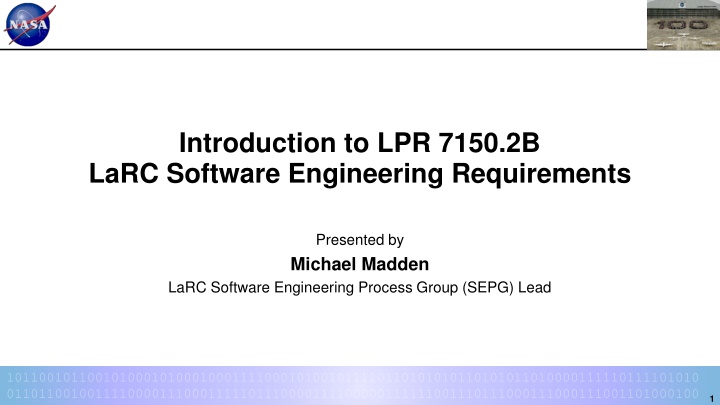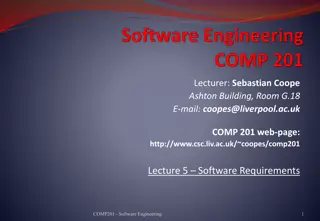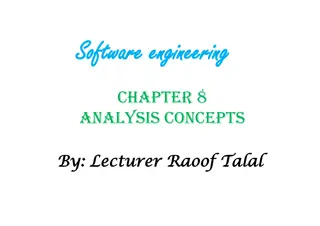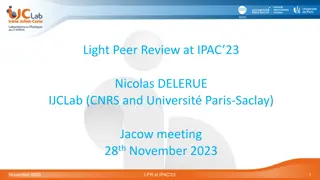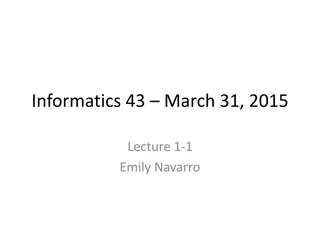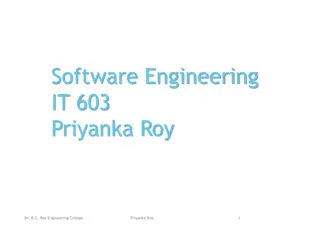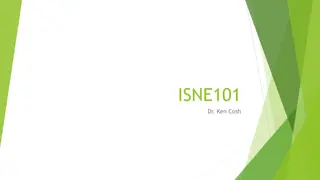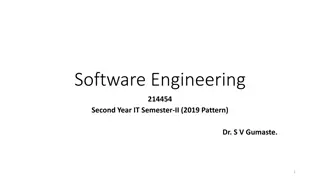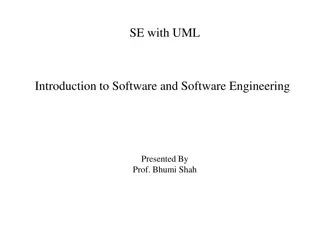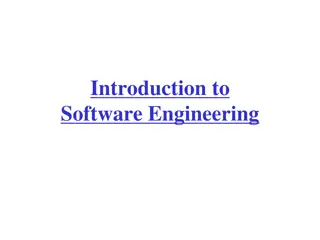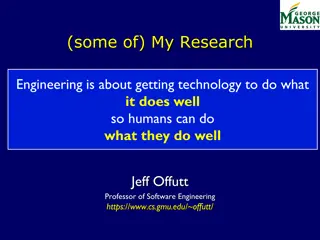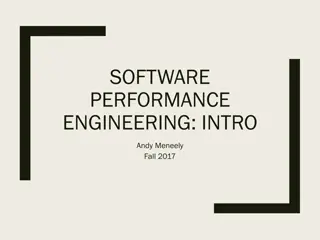Overview of LPR 7150.2B Software Engineering Requirements
This presentation covers an in-depth exploration of the LPR 7150.2B document, focusing on changes, audiences, course objectives, and project-level roles related to software engineering at LaRC. It discusses the relationship with Agency and LMS documents, navigating LPR 7150.2B, Langley's software activities, and more.
Download Presentation

Please find below an Image/Link to download the presentation.
The content on the website is provided AS IS for your information and personal use only. It may not be sold, licensed, or shared on other websites without obtaining consent from the author.If you encounter any issues during the download, it is possible that the publisher has removed the file from their server.
You are allowed to download the files provided on this website for personal or commercial use, subject to the condition that they are used lawfully. All files are the property of their respective owners.
The content on the website is provided AS IS for your information and personal use only. It may not be sold, licensed, or shared on other websites without obtaining consent from the author.
E N D
Presentation Transcript
Introduction to LPR 7150.2B LaRC Software Engineering Requirements Presented by Michael Madden LaRC Software Engineering Process Group (SEPG) Lead 1
Overview Audience Course Objectives What has changed? Document Relationships Document Structure LPR 7150.2B In-depth: Preface LPR 7150.2B In-depth: Chapter 1 LPR 7150.2B In-depth: Chapters 2 & 3 Project Level Roles Software Classification Compliance Matrix Tailoring Approvals Software Documents, Records, and Data Acquisition Project Portfolios LPR 7150.2B In-depth: Appendix G 2
Audience Contracting Officers and Contracting Officer Representatives Chief Engineers Technical Authorities for software Branch Heads Program and Project Leads NASA Software Leads (an LPR 7150.2B role) Leads for teams that develop, maintain, operate, retire, manage, acquire, or assure software 3
Course Objectives Learn what is changed in LPR 7150.2B Learn how LPR 7150.2B relates to Agency and LMS documents Learn how to navigate LPR 7150.2B to find information relevant to you Learn how LPR 7150.2B adapts NPR 7150.2B to Langley s software activities Langley-specific terms, concepts, and roles for software engineering Langley implementation of requirements levied on the Center Langley allocation of NPR 7150.2B requirements to the Government Langley s implementation and guidance on NPR 7150.2B requirements tailoring Langley guidance on compliance matrices and software engineering documentation This course does not cover how a project develops a software engineering process that complies with NPR 7150.2B The NASA Office of the Chief Engineer has developed a series of software engineering courses that cover this topic. One or more of these courses can be brought to Langley with sufficient interest and funds. 4
What Has Changed? (1/2) Responding to major changes in NPR 7150.2B Tailoring authority moved from center-level with Headquarters concurrence to project-level with technical authority approval Technical documentation content demoted to guidance and moved to the NASA Software Engineering Handbook Centers required to maintain cost repositories for Class A, B, and C software Responding to changes requested by organizational units (OU) Centralize the technical document content from LMS-CP-7150.x series to LPR 7150.2 Segregate programmatic from lifecycle requirements in LMS-CP-7150.x series Langley rarely flows programmatic requirements to contracts Using one approved compliance matrix for an application domain within the OU Permit delegation of technical authority for software to branch heads or other software discipline leads in the OU per LPR 7120.4 LaRC Technical Authority Implementation Plan Insert engineering responsibilities for the software release process 5
What Has Changed? (2/2) LMS-CP-7150.x series is cancelled Part of the Center tailoring under NPR 7150.2A Technical documentation content was moved to LPR 7150.2B Appendix E Requirements that are a Government responsibility were moved to LPR 7150.2B LPR 7150.2B refers the project to NPR 7150.2B for remaining requirements LMS-CPs for Class D and Class E Software were combined into LPR 7150.2B Appendix G Compliance Matrices now trace directly to NPR 7150.2B requirements LPR 7150.2B introduces project portfolios to bundle projects using common processes under one compliance matrix LPR 7150.2B introduces NASA Software Lead role to manage NPR 7150.2B requirements that are the Government s responsibility LPR 7150.2B formalizes the role of Center Software Assurance Manager for independent assessment of software class and safety-criticality 6
Document Relationships NASA-STD-8739.8 Software Assurance Standard NASA-STD-8719.13 Software Safety Standard NPR 7150.2B NASA Software Engineering Requirements invokes invokes applicable applicable refer refer LAPD 1150.2 Councils, Boards, Panels, Committees, Teams, and Groups LPR 7150.2B Langley Software Engineering Requirements LMS-CP-4754 Software Assurance (SA) for Development and Acquisition SEPG SA Waivers SR TA LPR 7120.4 Technical Authority Implementation Plan LMS-CP-7151 Obtaining Waivers for LMS Requirements LMS-CP-1724 Software Release SA SEPG Software Assurance Software Engineering Process Group SR TA Software Release Technical Authority 7
Document Structure (1/4) LPR 7150.2B consists of a main body and a set of appendices Main body All text in black is normative (required) All text in grey is informative The Government is responsible for requirements not assigned to the project or to projects Appendices are informative except The main body invokes Appendices D and F The Engineering Technical Authority can require adherence to Appendix E LPR 7150.2B LaRC Software Engineering Requirements Main Body Preface Chapter 1 Center Level Requirements Chapter 2 Project Level Requirements Chapter 3 Tailoring and Waivers Appendices Appendix A Supplemental Definitions Appendix B Abbreviations Appendix C References Appendix D LaRC Guidance on Compliance Matrices Appendix E Recommended Document Contents Appendix F LaRC Software Metrics Repository Data Appendix G Simplified NPR 7150.2B for Class D and Class E (Not Safety-Critical) 8
Document Structure (2/4) Content: Purpose of document, scope of applicability, sources of authority, applicable documents, verification of requirements, LMS cancellations, contacts for help with document Audience: Everyone LPR 7150.2B LaRC Software Engineering Requirements Main Body Preface Chapter 1 Center Level Requirements Chapter 2 Project Level Requirements Chapter 3 Tailoring and Waivers Content: NPR 7150.2B requirements and other software- related activities assigned to Center-level roles Audience: Engineering Directors, Program and Project Managers, Center Chief Engineer, Software Engineering Process Group, LaRC Representative to the Software Working Group, Head of Mission Assurance Branch, Collaboration & Talent Development Branch Appendices Appendix A Supplemental Definitions Appendix B Abbreviations Appendix C References Appendix D LaRC Guidance on Compliance Matrices Appendix E Recommended Document Contents Appendix F LaRC Software Metrics Repository Data Appendix G Simplified NPR 7150.2B for Class D and Class E (Not Safety-Critical) Content: NPR 7150.2B requirements and other software- related activities assigned to projects Audience: NASA Software Leads, Center Software Assurance Manager, Project Software Managers, Technical Authorities 9
Document Structure (3/4) Content: Tailoring of NPR 7150.2B requirements; LMS waivers Audience: Technical Authorities, NASA Software Leads LPR 7150.2B LaRC Software Engineering Requirements Main Body Preface Chapter 1 Center Level Requirements Chapter 2 Project Level Requirements Chapter 3 Tailoring and Waivers Content: Definition of terms in LPR 7150.2B that are not defined in NPR 7150.2B; abbreviations and references appearing in the LPR. Audience: Everyone Appendices Appendix A Supplemental Definitions Appendix B Abbreviations Appendix C References Appendix D LaRC Guidance on Compliance Matrices Appendix E Recommended Document Contents Appendix F LaRC Software Metrics Repository Data Appendix G Simplified NPR 7150.2B for Class D and Class E (Not Safety-Critical) Content: Content of compliance matrices; use of not applicable ; LaRC guidance on applying NPR requirements to lower classes; matrix entries for requirements implemented in the LPR Audience: NASA Software Leads, Technical Authorities, Project Software Managers, Center Software Assurance Manager, Supervisors 10
Document Structure (4/4) LPR 7150.2B LaRC Software Engineering Requirements Content: LaRC recommendations for the type and content of technical documents and records for software projects by class and safety-criticality Audience: Technical Authorities, NASA Software Leads, Project Software Managers Main Body Preface Chapter 1 Center Level Requirements Chapter 2 Project Level Requirements Chapter 3 Tailoring and Waivers Content: For the Langley Software Metrics Repository, this appendix defines the submission milestones and the data submitted at each milestone Audience: NASA Software Leads and Project Software Managers for projects developing Class A, Class B, Class C or safety-critical systems. Appendices Appendix A Supplemental Definitions Appendix B Abbreviations Appendix C References Appendix D LaRC Guidance on Compliance Matrices Appendix E Recommended Document Contents Appendix F LaRC Software Metrics Repository Data Appendix G Simplified NPR 7150.2B for Class D and Class E (Not Safety-Critical) Content: Simplified, information-mapped presentation of NPR 7150.2B requirements mapped to Class D or Class E systems that are not safety-critical Audience: NASA Software Leads and Project Software Managers for projects developing systems that are Class D or Class E and not safety-critical. 11
LPR 7150.2B In-depth: Preface (1/3) NPR 7150.2B Software Classifications Class A: Human Rated Space Software Systems Class B: Non-Human Space Rated Software Systems or Large Scale Aeronautics Vehicles Class C: Mission Support Software or Aeronautic Vehicles, or Major Engineering/Research Facility Software Class D: Basic Science/Engineering Design and Research and Technology Software Class E: Design Concept and Research and Technology Software Class F: General Purpose Computing, Business and IT Software (Multi-Center or Multi- Program and Project) Class G: General Purpose Computing, Business and IT Software (Single Center or Project) Class H: General Purpose Desktop Software LPR 7150.2B covers Langley s application of NPR 7150.2B requirements to the engineering classes (A through E) The Office of the Chief Information Officer (OCIO) responsible for providing guidance on applying NPR 7150.2B to the information technology classes (F through H) Theses classes are out of scope for LPR 7150.2B 12
LPR 7150.2B In-depth: Preface (2/5) What activities are in scope? All software engineering activities including development, maintenance, operations, retirement, management, acquisition, and assurance that are performed by or for LaRC Any program, project, task, contract, grant or partnership that performs software engineering Applicability for contracts, grants, or partnerships is as defined in the agreement with NASA Who is in scope? Civil servants, interns, contractors, grantees, and partners participating in an in-scope activity What products are in scope? Computer programs, procedures, scripts, rules, and associated documentation and data pertaining to the development and operation of a computer system. This definition applies to software developed by NASA, software developed for NASA, commercial-off-the-shelf (COTS) software, Government-off-the-shelf (GOTS) software, modified-off-the-shelf (MOTS) software, reused software, auto-generated code, embedded software, the software executed on processors embedded in Programmable Logic Devices (see NASA-HDBK- 4008), and open-source software components. NPR 7150.2B 13
LPR 7150.2B In-depth: Preface (3/5) What products are in scope? (cont.) Decoder: if a product ultimately executes on a processor, it is software. This includes execution on central processing units (CPUs), graphical processing units (GPUs), many integrated core (MIC) chips, and programmable logic controllers (PLCs). Doesn t matter how or where the software image is stored: hard disk, non-volatile memory (e.g. flash memory), or read-only memory (ROM); i.e., scope includes firmware and embedded software. Decoder: Documentation or data is also in scope if it is a software engineering work product or it is necessary to execute the software for its intended purpose. For example, Data used to assess the outcome of software tests is in scope Configuration files read by the software during execution are in scope LPR divides software into developed software and non-developed software Developed software is new software or software modifications Non-developed software is acquired (e.g., off-the-shelf) or reused software 14
LPR 7150.2B In-depth: Preface (4/5) Exceptions If a product is ultimately realized as a gate design on a chip, it is not software and not in scope. It is a complex electronics product. Classes F, G, and H. The OCIO provides guidance for these classes. A software activity started before May 14, 2013 (effectivity date of LPR 7150.2A) This LPR does not apply if solely acquiring non-developed software for unmodified use outside the context of a NASA system LPR 7150.2B Decoder: LPR does not apply to embedded software in devices that are not integrated into a NASA system (e.g. a purchased oscilloscope may contain embedded software - not in scope). 15
LPR 7150.2B In-depth: Preface (5/5) Exceptions (cont.) This LPR does not apply to non-safety critical, standalone software that: Has no anticipated delivery, and; Is not the subject of a publication or delivered/published analyses, and Is not included in a system that is being delivered, and Will not be used to make decisions on Class A, B, C, or D systems. LPR 7150.2B Decoder: If the software has value only to its author, it is not in scope The exemption is intended for software that an individual writes at their desk to perform back of the envelope calculations or improve personal productivity In the exemption, the term software does not include the software s output in scope; therefore, the software can be exempt even its outputs are published The software has value to others and the exemption does not apply If the software is delivered, released, shared, or published If the software becomes a reportable item to a project or organization If the software executes in a NASA system (e.g., labs, facilities, aircraft, spacecraft) If the software output is used to make decisions on the specification, design, implementation, verification, validation, operation, or maintenance of a NASA system 16
LPR 7150.2B In-depth: Chapter 1 (5/5) Chapter 1 Center Level Requirements Defines the Langley implementation of NPR 7150.2B requirements that the NPR assigns to the Center or Center-level roles Identifies the Center-level roles and responsibilities for software engineering Primary Audience Senior leadership Engineering Directors Center Chief Engineer Head of the Mission Assurance Branch LaRC Collaboration & Talent Development Branch Software Engineering Process Group (SEPG) Members Representatives to the Agency Software Working Group (SWG) Program and Project Managers 17
LPR 7150.2B In-depth: Chapter 1 (2/5) Appointments Directorate Representative to the SEPG Engineering Director appoints Center Chief Engineer LaRC Representative to Agency SWG appoints Center Software Assurance Manager Head, Mission Assurance Branch appoints SEPG SWG = Software Engineering Process Group = Software Working Group 18
LPR 7150.2B In-depth: Chapter 1 (3/5) Software Engineering Process Group (SEPG) Maintains LPR 7150.2B Maintains, staffs, and implements the Center Plan for LaRC Software Process Improvement Advance and monitor software engineering capability Copy available at http://sw-eng.larc.nasa.gov/ Establish and maintain the LaRC Software Metrics Repository Collects measures from Class A, Class B, Class C, and safety-critical software projects List of measures in LPR 7150.2B Appendix F Forms at https://sw-eng.larc.nasa.gov/metrics-collection/ Analyzes measures and reports results to Chief Engineer s Board annually Maintain and implement a software training plan Solicits software assets from organizational units for Agency process asset library See charter in LAPD 1150.2 Councils, Boards, Panels, Committees, Teams, and Groups 19
LPR 7150.2B In-depth: Chapter 1 (4/5) Program and Project Managers Ensure that plans, resources, procurements, and agreements support compliance with NPR 7150.2 requirements Ensure application of other laws and NASA policy requirements that pertain to software: Invention disclosure Intellectual property rights Software release Technology transfer Information security Accessibility for individuals with disabilities Independent Verification & Validation (IV&V) Human rating requirements Exchange of problem data between government and industry on NPR 7120.5 projects 20
LPR 7150.2B In-depth: Chapter 1 (5/5) LaRC Representative to the Software Working Group Reports on the status of the Center s software engineering discipline to the NASA Office of the Chief Engineer Maintains a reliable list of LaRC programs and projects containing Class A, B, C, or D software LaRC Collaboration & Talent Development Branch Provide and fund training to advance software engineering practices and software acquisition Accomplished as part of the training call process with input from SEPG 21
LPR 7150.2B In-depth: Chapters 2 & 3 (1/2) Chapter 2 Project Level Requirements Defines the Langley adaptation of select NPR 7150.2 requirements assigned to projects Primarily addresses requirements Langley has assigned to the Government Identifies the project-level roles and responsibilities for software engineering Introduces the concept of project portfolios Chapter 3 Tailoring and Waivers Covers documentation and approval of tailoring or waiver requests Coverage will also include Appendices D, E, and F Primary Audience Center Software Assurance Manager* NASA Software Leads* Project Software Managers* Technical Authorities * Role defined by LPR 7150.2B 22
LPR 7150.2B In-depth: Chapters 2 & 3 (2/2) Topics Project Level Roles Software Classification Compliance Matrix LaRC Guidance on Compliance Matrices (Appendix D) Tailoring Approvals Software Documents, Records, and Data LaRC Recommended Document Contents (Appendix E) LaRC Software Metrics Repository Data (Appendix F) Acquisition Project Portfolios 23
Project Level Roles Center Software Assurance Manager Responsible for independent classification and safety-critical determination of software Performs software assurance on NPR 7150.2 Compliance Matrices Leslie Johnson is the current Center Software Assurance Manager NASA Software Leads Designated by the line manager of the LaRC organization responsible for the software task Responsible official for project-level requirements assigned to the Government Can rely on contract support to accomplish requirement Project Software Managers Introduced in LPR 7150.2B Appendix G Responsible for other project-level requirements in NPR 7150.2 (which can be assigned to suppliers) Can be the same person as the NASA Software Lead Technical Authority (TA) Designated per LPR 7120.4 LaRC Technical Authority Implementation Plan Engineering TA, which is held by Directorate Directors, can be delegated to Branch Heads 24
Software Classification Center Software Assurance Manager LPR 7150.2B assigns responsibility for software classification to the Government NPR 7150.2B requirements affect acquisition and other agreements Both the Engineering TA and SMA TA participate in resolution of dissenting opinions on software classification The NASA Software Lead monitors project for changes that elevate classification or safety-criticality Reapplies LPR 7150.2B and NPR 7150.2B based on new classification and safety- critical determination NASA Software Lead Assess software class and safety-criticality Independently assess software class and safety-criticality send assessment Apply NPR 7150.2 requirements per software class and safety-criticality Yes, send Reach agreement? SACR No Resolve dissenting opinions per LPR 7120.4 SACR SMA TA = Software Assurance Classification Report = Safety and Mission Assurance = Technical Authority 25
Compliance Matrix (1/5) The Compliance Matrix identifies who is responsible for each NPR/LPR 7150.2B requirement documents tailoring of requirements approved by the Technical Authority does not document how the requirement is implemented The NASA Software Lead is the responsible official for the Compliance Matrix The Government decides what requirements it will flow to contractors, grantees, or partners before initiating agreements The Government assesses and approves any tailoring of requirements The Center Software Assurance Manager Performs software assurance on all compliance matrices Audits conformance of the project to its compliance matrix (or matrices) No audits for Class E Random sampling of projects for Class D and not safety-critical All other projects audited per LMS-CP-4754 26
Compliance Matrix: LPR Mods (2/5) Software Class Class A, Class B, Class C, or Safety-Critical Class D Requirement Old Mapping New Mapping Description and Rationale LSWE-031 None X Submit data to the LaRC Software Metrics Repository per SWE-091 and SWE-142. LSWE-030 None X Submit software inventory data per SWE-006. LSWE-030 None X Submit software inventory data per SWE-006. SWE-035 X X Supplier selection. Projects are required to follow Office of Procurement procedures regardless of class or safety-criticality. Make vs. buy and supplier selection. Projects are required to follow Office of Procurement procedures regardless of class or safety-criticality. *(S/C only) SWE-033 SWE-035 <blank> <blank> X X Class E SWE-066 <blank> X Software testing. The Center requires all software, regardless of class or safety-criticality, to be tested. Class E testing can be ad-hoc and informal. LPR 7150.2B Modifications to the NPR 7150.2B Requirements Mapping Matrix 27
Compliance Matrix: Compliance Levels (3/5) The LPR defines three levels of compliance for a requirement: FC full compliance. T tailored. NA not applicable. Limited to requirements with a known applicability restriction. T used to tailor down, tailor out, or replace a requirement Requires technical authority approval NA is limited to requirements with a known applicability restriction Some requirements apply only for acquisitions, only for spaceflight projects, only when safety-critical (for Class C or Class D), or only for Independent Verification &Validation. These requirements are listed by category in Appendix D.2 NA marking does not require TA approval NA cannot be used against generally applicable requirements Use T (tailor) to remove a generally applicable requirement; this is a tailor-out action. 28
Compliance Matrix: Content (4/5) LPR 7150.2B Appendix D.1 defines content of Compliance Matrix For each requirement mapped to the software class and safety-criticality: Requirement identifier from NPR 7150.2 (SWE-nnn) or LPR 7150.2 (LSWE-nnn) Responsible party for the requirement Level of compliance with the requirement Description explaining T or NA compliance marking Justification for T compliance marking Signatories NASA Software Lead (approver) NASA Software Lead's Supervisor (approver) Center Software Assurance Manager (concurrence) Engineering Technical Authority (approver if compliance matrix includes tailoring) SMA Technical Authority (approver per section 3.2 if compliance matrix includes tailoring) The project or organization is free to decide format SEPG provides templates at https://sw-eng.larc.nasa.gov/supporting-products/ 29
Compliance Matrix: Other Topics (5/5) Appendix D.3 Intent Clarifications for Select NPR 7150.2 Requirements NPR 7150.2B requirements are written for Class A Therefore, some requirements do not translate well to lower classes Appendix D.3 provides modified requirements text that expresses LaRC s recommended intent of select requirements to a given software class Rationale for the modified text is also provided Appendix D.4 Project Requirements Implemented in LPR 7150.2B LPR 7150.2B implements 10 requirements assigned to projects Includes requirements covering software classification, the compliance matrix, and tailoring of NPR 7150.2B requirements plus three acquisition requirements Appendix D.4 lists these requirements in a table with responsible party, compliance level (all FC), and the LPR paragraph containing the implementation 30
Tailoring Approvals (1/2) Section 3 defines approval for tailoring of NPR/LPR 7150.2 requirements An LMS Waiver per LMS-CP-7151 is required to tailor: Requirements that are not the responsibility of the project (e.g. Center-level requirements) Requirements that NPR 7150.2 does not delegate to the Center Director SWE-032 CMMI and SWE-141 IV&V Requirements that LPR 7150.2 does not delegate to the Directorate Directors SWE-020, SWE-021, SWE-132, SWE-133, SWE-125, SWE-139, and SWE-145 These cover software classification and the compliance matrix The designated Engineering TA can approve tailoring of all other requirements Approval by the designated SMA Technical TA is also required For any tailoring when the software is safety-critical When tailoring SWE-022, SWE-023, SWE-032, SWE-131, SWE-134, SWE-141 or SWE-160 These requirements cover software assurance, software safety, CMMI and IV&V 31
Tailoring Approvals (2/3) The TA assesses the compliance matrix and tailoring per SWE-126 Checks the accuracy of the project s classification of software components Evaluates the compliance matrix for commitment to meet requirements mapped to the software class(es) Confirming that requirements marked Not-Applicable in the project s compliance matrix are not relevant or not capable of being applied This applies to both the NA compliance level and tailor out under T compliance level Determining whether the project s risks, mitigations, and related requests for relief from requirements are reasonable and acceptable. Coordinate with the Center SMA organization that the compliance matrix and tailoring does not impact safety and mission assurance on the project Approving/disapproving requests for relief from requirements as delegated Facilitating the processing of projects tailoring or waivers from requirements which falls under the responsibilities of a different Technical Authority Ensuring that approved compliance matrices, including any tailoring, are archived 32
Tailoring Approval (3/3) When tailoring requires an LMS waiver per LMS-CP-7151 The NASA Software Lead submits the request The Engineering and SMA Technical Authority chains are the Recommending Authorities Starting with the designated Engineering and SMA Technical Authorities for the software task For requirements not delegated to the Engineering Directors, the Approvers are the Center Chief Engineer and the Director of the Safety and Mission Assurance Office For requirements not delegated to the Center Director, the Approver is the Center Director In other words, the Center Director first approves any waivers to be submitted to Headquarters The Center Director then forwards the request, for final approval, to the Headquarters Chief Engineer and the Headquarters Chief for Safety and Mission Assurance The designated Engineering TA retains a copy of the approved compliance matrix with tailoring as a retrievable, archived record 33
Software Docs, Records, and Data (1/3) The Engineering TA defines the content requirements for software engineering documents and records of the project For safety-critical software, the Engineering TA coordinates content with the SMA TA The SMA TA defines the content requirements for software assurance documents and records of the project Appendix E assists the Engineering TAs by providing recommended content by software class The Engineering TA can simply apply Appendix E to a project The Engineering TA can also augment Appendix E or create an alternative set of content requirements (e.g. using IEEE or ISO standards) 34
Software Docs, Records, and Data (2/3) Except for Class E, the NASA Software Lead provides the following data to the LaRC SWG Representative for the software inventory at project start: Name of project Work breakdown structure (WBS) number (in the NASA financial system) Name and contact information for the NASA Software Lead Name of the development organization(s) Name of the software assurance organization(s), if applicable Primary lifecycle methodology Current lifecycle phase For each software item, provide the following information: Name of item Estimate of software size as KSLOC (thousand source lines of code) Software class and safety-critical determination The primary programming language 35
Software Docs, Records, and Data (3/3) Except for Class E, the NASA Software Lead defines the acceptance criteria and conditions for the software Defines the criteria by which the Government will accept the software for its intended use Criteria may be evaluated under conditions such maximum resource load, an operational mode, a user access control level, in the presence of intrusion attempts, etc. Except for Class E, the NASA Software Lead evaluates software for contribution to the Agency Software Catalog as reusable software During formulation, the NASA Software Lead should consider the necessary intellectual property rights to permit sharing of the software Currently requires submitting software through the software release process, LMS-CP-1724 The project submits a New Technology Report (NTR) for developed software NTRs are submitted online via http://invention.nasa.gov Should start the NTR when the software need is first identified A new NTR is expected for future revisions of the software that add new features 36
LaRC Software Metrics Repository (1/3) Data submission required for Class A, Class B, Class C, or safety-critical The NASA Software Lead is responsible for this requirement Data requirements are defined in Appendix F Data submission is multi-phase as shown on left Create Project Start of project formulation. Start Development The Software Management Plan is approved. End Development The software is completed and transitioned to operations and maintenance. Start Maintenance The software is placed under maintenance. Annual Maintenance The start of each fiscal year between Start Maintenance and End Maintenance. End Maintenance The project is closed and the software (or this major revision) is removed from service Measurement Milestones Create Project Start Development End Development Start Maintenance Annual Maintenance End Maintenance 37
LaRC Software Metrics Repository (2/3) LaRC Software Metrics divides projects into two types Development Projects develop or upgrade a software item to a defined set of requirements under a budget and schedule Maintenance Projects make bug-fixes or enhancements in response to user requests Typically budgeted at a level of effort A Development Project transitions to a Maintenance Project after the software item is accepted for use A project that only maintains off-the-shelf software can begin as a Maintenance Project Measurement milestones that apply to each project type shown on left Measurement Milestones All Projects Create Project Start Development Development Project End Development Start Maintenance Maintenance Project Annual Maintenance End Maintenance 38
LaRC Software Metrics Repository (3/3) Projects submit data using Excel workbooks located at: https://sw-eng.larc.nasa.gov/metrics-collection/ The is one workbook for Development Projects and a second for Maintenance Projects A Development Project will eventually fill out both workbooks, switching to the workbook for Maintenance Projects after the software is accepted for use Each Excel workbook has an instruction sheet and a sheet for each measurement milestone In the workbook for maintenance projects, there are multiple sheets for the annual maintenance milestone, each named by fiscal year Name the workbook <Development | Maintenance>_Project_Metrics_<project name>.xlsx At each measurement milestone, the NASA Software Lead updates the workbook by filling in the sheet associated with that milestone E-mails the updated workbook to larc-dl-sepg@mail.nasa.gov Appendix F has a table listing each measure to be submitted and the measurement milestone(s) when the submission is made 39
Acquisition (1/2) The NASA Software Lead is responsible for The make vs. buy decision (SWE-033) Contacting the LaRC Office of Procurement to acquire software items or services (SWE- 035) When acquiring non-developed software, consulting with the Office of the Chief Counsel to assess whether intellectual property rights and licenses are agreeable to LaRC and meet the needs of the project Since LPR was written, the Agency has issued new software license management requirements and the process now begins with an ITAM (IT Asset Management) request Also required for open source software When planning to release software developed or acquired via procurement, consulting with the Office of the Chief Counsel and the Office of Procurement to assure that LaRC receives the necessary intellectual property rights and licenses to the acquired software item Identifying the NPR/LPR 7150.2B requirements to flow down to the supplier and assuring they are documented in the compliance matrix, solicitation, and final agreement 40
Acquisition (2/2) The NASA Software Lead is responsible for (cont.) Defining the technical work (e.g. statement of work) for the software activity Except for Class E, define the acceptance criteria and conditions for deliverables Assures that the solicitation and final agreement address NPR 7150.2 requirements for acquisition and supplier management, as applicable by software classification Assures, as appropriate, that the solicitation and final agreement include delivery of data for the software inventory and LaRC Software Metrics Repository When the software is Class A, Class B, Class C, or safety-critical, the NASA Software Lead and the Center Software Assurance Manager identify the NASA-STD-8739.8 software assurance requirements to flow down to the supplier When the software is safety-critical, the NASA Software Lead and the SMA TA identify the NASA-STD-8710.13 software safety requirements to flow down to the supplier The NASA Software Lead and Engineering TA identify and define the deliverable software plans and work products 41
Project Portfolios When a organization manages multiple software tasks within the same domain, the organization can combine those tasks into a project portfolio. Two options to manage the portfolio Manage all tasks under one umbrella software management plan (SMP) Establish a software policy and common software engineering processes The umbrella SMP or the software policy defines the domain of the portfolio Tasks in a project portfolio can share a Compliance Matrix Tasks must still be classified individually The term project portfolio can substitute for project in LPR text Software Policy Umbrella Software Management Plan Common Software Processes Software Tasks Project Plan Project Plan Project Plan Software Task Software Task Software Task 42
LPR 7120.2B In-Depth: Appendix G Provides a Reader s Digest representation of NPR 7150.2B for projects that are Class E or Class D and not safety-critical Class E is two pages Class D (and not safety-critical) is five pages Projects can use Appendix G as a substitute for NPR 7150.2B NPR 7150.2B requirements provided in an information-mapped format like prior LMS-CP-7150.x series A graphical flow of steps A step-action table to detail each step Covers project requirements assignable to either civil service or suppliers The first step covers the Government activity detailed in Chapters 2 & 3 Therefore this appendix can be used as a reference in acquisitions 43
How to Get Help on LPR 7150.2B? Contact your Directorate SEPG Representative The list of Directorate SEPG Representatives is found on the home page of the LaRC Software Engineering web-site http://sw-eng.larc.nasa.gov Send an e-mail to larc-dl-support-sepg-help@mail.nasa.gov The SEPG help line Also listed on the home page of the LaRC Software Engineering web-site 44
Questions? 45
